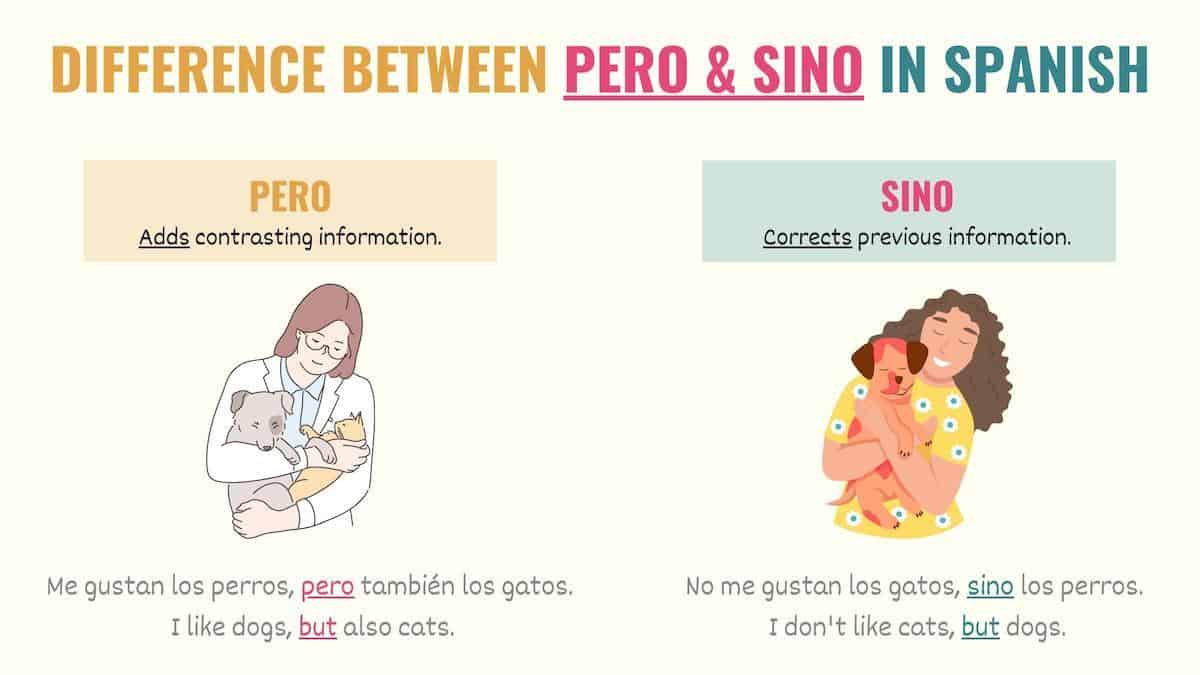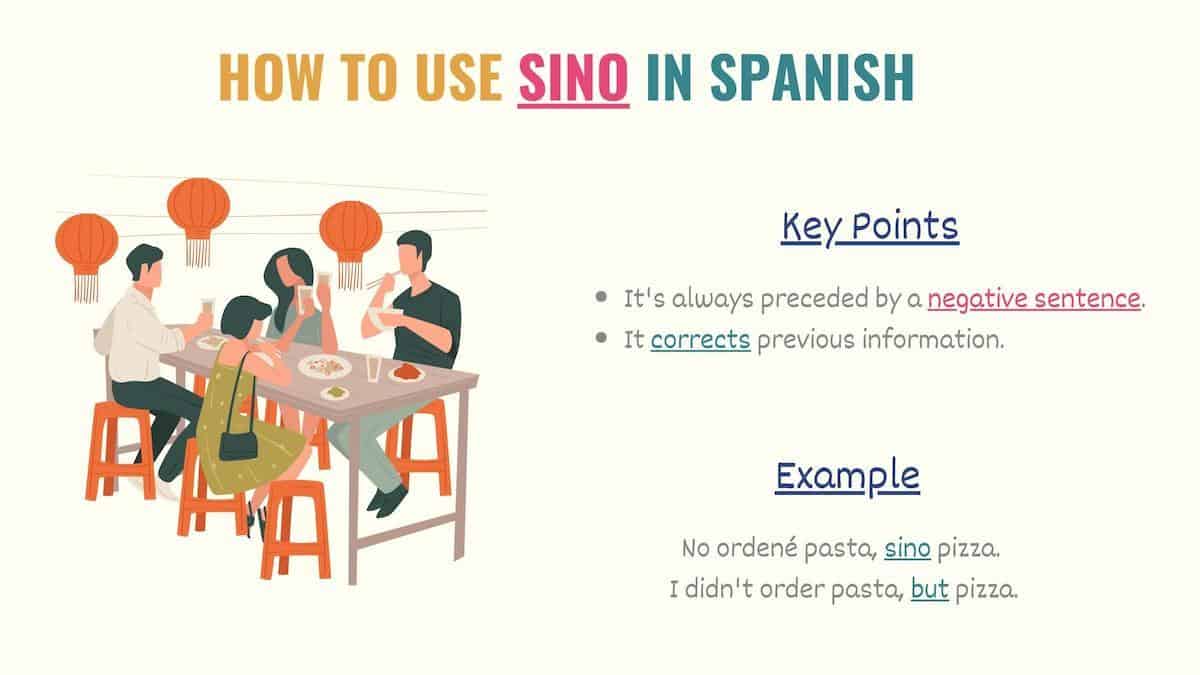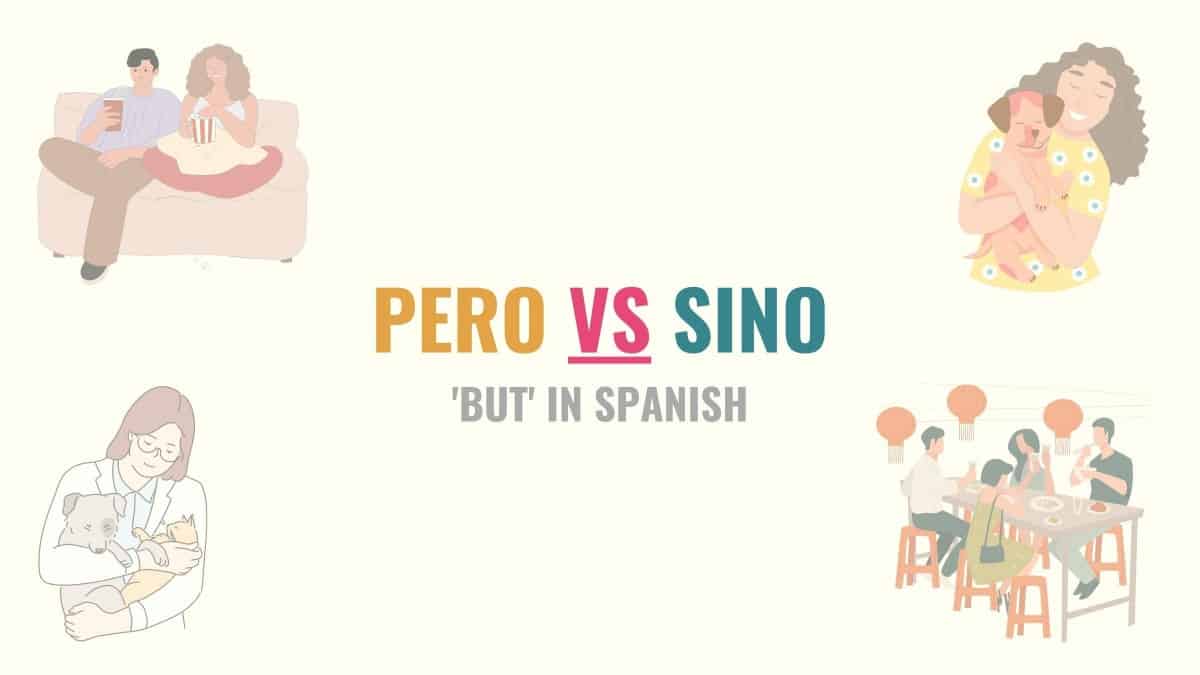Both pero and sino mean ‘but’ in Spanish. However, these words are not synonyms since they have slightly different functions. So, understanding pero vs sino is essential to correctly say ‘but’ in Spanish.
Telling the difference between pero and sino can be challenging for new and experienced Spanish learners. But seeing how important these words are, in this short guide, you’ll learn:
- What Is the Difference Between Pero and Sino?
- When and How to Use Pero in Spanish
- When to Use Sino in Spanish
- Key Points
- Take Practice Quiz
By the end of it, pero and sino will no longer be a problem for you!
What’s the Difference Between Pero and Sino in Spanish?
In Spanish, pero and sino are used to join ideas or statements. This may lead people to think that these words are interchangeable. However, the type of connection they make is different.
Pero is used to adding contrasting information to a previous statement. Therefore, it means ‘but’, ‘however’, or ‘nevertheless’. On the other hand, sino is used to correct previous information. Sino can be translated as ‘but’, ‘but rather’ or ‘but instead’.
Check the examples in the graphic below.

As ‘but’ works in English, pero joins sentences together, however the second statement adds contrasting information. For instance:
Esta falda es bonita, pero muy cara.
This skirt is pretty but expensive.
Estoy llena, pero me voy a terminar la hamburguesa.
I’m full, but I’m going to finish my burger.
In Spanish, sino also joins two sentences. However, when making this connection, sino corrects the information from the first sentence. Additionally, sino only works with negative statements. For example:
Lena no es francesa, sino alemana.
Lena is not French, but German.
Aquí no se usa el pretérito, sino el imperfecto.
Here we don’t use the preterite but the imperfect.
Now that you have a general idea of the difference between pero and sino, let’s dive in deeper to see how and when to use these words.
Tip: Pero and sino connect sentences to make them more fluid and natural. Like these terms, there are many transition words in Spanish that can help you improve the flow of your sentences.
When and How to Use Pero in Spanish
Pero in Spanish is used to join two sentences while adding opposing, differing, or contradicting information. In other words, the second statement has information that will contrast with the previous sentence. As a result, this conjunction can be translated as:
- But
- However
- Nevertheless
Additionally, pero works with both negative and affirmative sentences. Below are some examples and a formula you can follow when using this word:
[Statement #1] + pero + [Statement #2]
Vivimos en una casa pequeña, pero muy bonita.
We live in a small but pretty house.
Quiero ir al cine, pero no tengo tiempo.
I want to go to the movies but don’t have time.
La falda es muy bonita, pero no la quiero.
The skirt is very pretty, but I don’t want it.
Emily es inteligente, pero muy grosera.
Emily is smart but very rude.
Check the examples above. The sentences after pero convey an idea that contrasts with the information provided in statement #1. However, these statements are just adding more facts.
Take Note: Unlike sino, the statement that comes after pero is not meant to correct previous facts.
When and How to Use Sino in Spanish
In Spanish, sino joins two sentences together while correcting the information expressed in the previous statement. Sino is always preceded by a negative sentence. It means ‘but’, ‘but rather’ or ‘but instead’.
Below are some examples of how to use sino in a sentence. Notice that the word or phrase after sino corrects what we said before.
[Incorrect information] + sino + [noun/adjective/infinitive verb]
Esto no es agua, sino té.
This is not water but rather tea.
Ben no estudió italiano, sino español.
Ben didn’t study Italian but instead Spanish.
No queremos comer, sino dormir.
We don’t want to eat but sleep.
No pasaré el día contigo, sino con mi familia.
I won’t spend the day with you, but rather with my family.

Take Note: Sino always joins words from the same type (nouns with nouns, verbs with verbs, etc). In simple terms, if my first sentence contains a noun, the word that follows sino must also be a noun. You can see this pattern in the examples above.
Other forms of sino
Sino que also corrects previous information. However, it’s only used in front of a conjugated verb:
No vendí la casa, sino que la renté.
I didn’t sell the house, but rented it.
Juan no se irá de vacaciones, sino que trabajará.
Juan won’t take vacation but will work.
No solo…sino también is a more advanced structure you can form with sino. This is a more complex structure we use to add more information to a previous statement. It’s the equivalent of ‘not only…but also’.
No sólo eres grosero, sino también tonto.
You’re not only rude but also dumb.
Mindy no sólo habla español, sino también inglés y francés.
Mindy speaks not only Spanish but also English and French.
Take Note: Do not confuse sino and si no. Sino (a single word) is used to correct a previous statement. On the other hand, si no (two words) is used to form conditional sentences in Spanish and can be translated as ‘if not’.
Key Points
Pero vs sino is a challenging topic because both words can be translated as ‘but’. However, using one term over the other depends on the message you are trying to convey. Here are some key points to remember:
- Pero joins two sentences while adding information that contrasts with the previous statement. It can be translated as ‘but’, ‘however’, or ‘nevertheless’.
- In Spanish, pero can work with both negative and affirmative sentences.
- Sino joins two sentences while correcting the information provided in the first statement. It means ‘but’, ‘but rather’, or ‘but instead’.
- Sino is always preceded by a negative (factually incorrect) statement.
- Depending on the elements of the sentence, sino can be followed by a noun, pronoun, adjective, or infinitive verb.
Incorrect
No estudio italiano, pero español.
I don’t study Italian, but Spanish.
La falda es bonita, sino cara.
The skirt is pretty but expensive.
Correct
No estudio italiano, sino español.
I don’t study Italian, but Spanish.
La falda es bonita, pero cara.
The skirt is pretty, but expensive.
Download Pero vs Sino Summary Notes PDF
Download a copy of the Pero vs Sino graphics, examples, and key notes on the difference between them as well as how and when to use them, respectively.
Practice Quiz: Pero vs Sino
Now that you understand the difference between pero and sino is time for you to start practicing these words. For starters, you could take this pero vs sino quiz.





